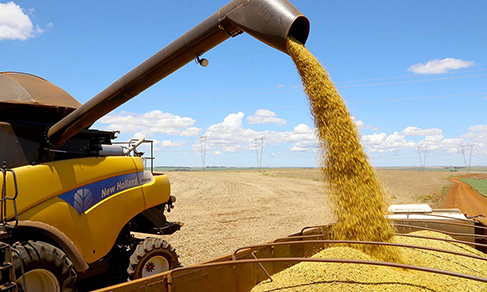Agricultural production
May estimate indicates crop 5.9% down in 2024, as a result of weather problems
June 13, 2024 09h00 AM | Last Updated: June 13, 2024 06h23 PM

The Brazilian crops of cereals, legumes and oilseeds is expected to reach 296.8 million tonnes according to the May estimate from the Systematic Survey of Agricultural Production (LSPA), released today (13) by the IBGE. This result is 5.9% lower, or 18.6 million tonnes below the crops obtained in 2023 (315.4 million tonnes) and 0.9% lower (2.8 million tonnes) than the April estimate.
The area to be harvested was 78.3 million hectares, an increase of 0.6% (454,502 hectares) compared to the area harvested in 2023 and growth of 0.6% (445,140 hectares) compared to April. Cotton was the only product to record production records.
“The reduction in production reflects the impact of weather problems that occurred in 2023 and 2024, since the beginning of crops, with the lack of rain in the Central-West region, with the high temperatures that shortened the cycle of some crops and reduced productivity. Some producers had to replant, such as soybeans, and others chose to increase the cotton area, whose production is breaking a record with an estimated 8.5 million tonnes, an increase of almost 10% compared to last year, which was also record”, analyzes Carlos Alfredo Guedes, IBGE Agriculture Manager.
The survey manager, Carlos Barradas, highlights that the drop in production is a reflection of the problems that occurred in the summer harvests and does not yet fully reflect the impact of the floods in Rio Grande do Sul. “There was a lack of rain in states like Mato Grosso do Sul, which showed a drop of 3.4 million tonnes in May estimates. In Rio Grande do Sul, 2.1 million tonnes fell and in Paraná, 457 thousand tonnes. There was a little offsetting with the increase of 2.6 million tonnes in Mato Grosso and 630.0 thousand tonnes in Minas Gerais, but the drops were greater, because there was a drought in Mato Grosso do Sul, an important grain producing state.”, says Mr. Barradas.
The estimate for soybeans is a production of 146.7 million tonnes, a drop of 3.5% compared to 2023 and 1.1% compared to April. Even with an increase in the planted area of 3.5% compared to last year and 0.8% compared to April. “This is due to weather problems, which are expected to result in lower productivity in 2024. Last year the weather was good in Rio Grande do Sul for soybeans, and a record crop was expected in 2024 for the state. With the recent floods, the estimate fell, but it remains a good crop, especially compared to that harvested in 2023”, explains the survey manager.
For corn, the estimate is for a production of 114.5 million tonnes with a decline of 1.1% compared to the previous month and 12.7% compared to 2023. The monthly reduction of 6.6% in production of corn 1st crop in Rio Grande do Sul, as well as 15.4% of corn 2nd crop in Mato Grosso do Sul impacted Brazilian production.
There was also a 4.7% decrease in the planted area (reductions of 8.6% in corn 1st crop and 3.5% in corn 2nd crop) and also in productivity. “There were weather problems in November and December affecting the harvest of corn 1st crop; corn second-crop saw a drop in production because prices fell a lot and producers chose other crops”, explains the LSPA manager.
Wheat production is expected to reach 9.6 million tonnes, a decline of 2.5% compared to the April estimate; and growth of 23.8% compared to 2023, when Brazil, despite initially expecting a record cereal crop, had its expectations frustrated due to a series of weather problems, which harmed crops in the South Region. “Wheat is not yet planted, it starts this June. As there was a lot of loss of fertility in the soil affected by the floods, this explains the drop compared to the previous month. But in relation to 2023, the expectation is for an increase”, predicts Mr. Barradas.
The LSPA estimates a production of 10.5 million tonnes for rice, however, with a lower productivity than in 2023, as a consequece of the weather problems in Rio Grande do Sul, the biggest rice producer.
“Most of the crops were already harvested, but what was still in the field was affected. The reduction in production in Rio Grande do Sul, in May, compared to the previous month, was offset by increases in Minas Gerais, where new production areas were identified, with a highlight to the municipalities of Paracatu and Unai, as well as production growth in Paraná (2.1%), Mato Grosso do Sul (4.9%), Goiás (9.8%) and Mato Grosso (18.1%). Rice production should be enough for the domestic market. The rains and floods in Rio Grande do Sul are expected to reduce production, but not enough to cause a lack of rice on the market”, concludes the survey manager, Carlos Barradas.
Stock capacity grows 4.7% in the 2nd half of 2023
The IBGE also released the Stock Survey today, which showed a 4.7% increase in the country's storage capacity compared to the first half of 2023, corresponding to 9.5 million tonnes more. With this increase, agricultural storage capacity reached 210.9 million tonnes. There was also an increase of 4.8% in the number of establishments, reaching 9,102 active establishments in the second half of 2023.
Silos predominated among the types of storage, with 110.0 million tonnes, which represents 52.2% of the total capacity. Next come bulk warehouses (77.8 million tonnes) and conventional, structural and inflatable warehouses, with a capacity of 23.1 million tonnes.
Of the 44.6 million tonnes of total stock of products investigated by the survey, on 12/31/2023, corn stocks represented the largest volume (21.0 million tonnes), followed by soybean stocks (11.3 million), wheat (6.4 million), rice (1.5 million) and coffee (1.1 million). These products constitute 92.7% of the total stock, with the remaining 7.3% made up of cotton, black beans, colored beans and other grains and seeds.
Also noteworthy is the growth of 39.6% in soybean stocks and 15.8% in corn stocks, compared to December 31, 2022. Wheat stocks fell 13.3% in this comparison.
The next Survey of Stocks will be released on November 14th.
About the LSPA
Implemented in November 1972 with the purpose of meeting users' demands for monthly cyclical statistical information, the LSPA provides estimates of planted area, harvested area, quantity produced and average yield of selected products based on criteria of economic and social importance for the country. It allows not only the monitoring of each crop investigated, from the planting intention phase until the end of the harvest, in the reference calendar year, but also the forecast of the following year's harvest, for which the survey is carried out in the months of October, November and December. Please, access data on Sidra. The next release of the LSPA will be on July 11th.




















